 |
|||||
|
|||||
| Preview of Stamps Catalogue: VOLUME 1 |
 |
|||||
|
|||||
| Preview of Stamps Catalogue: VOLUME 1 |
Return To Catalogue - Issues of 1880-1901 - Issues of 1902-1920 - Miscellaneous (revenues postal stationery etc.)
Note: on my website many of the
pictures can not be seen! They are of course present in the catalogue;
contact me if you want to purchase it.
Remark: Many of the stamps presented here are from the private collection of Peter C. Elias (website http://www.stvincentstamps.com ), thanks Peter for letting me use your images! All images starting with 'elias' are taken from him.
St.Vincent is a small volcanic island in the West Indies, situated at 13º 15' N and 60º 56' W, between St Lucia to the north and Grenada to the south and west of Barbados. Kingstown is the capital of St. Vincent. On October 27, 1979 St. Vincent became independant from Great Britain.
Before the introduction of its own stamps in 1861, St.Vincent used stamps from Great Britain. At 1 April 1858 stamps were compulsary on letters to Great Britain. St.Vincent used the "A10" cancel. Officially, only the 1 p, 4 p and 6 p were used in St.Vincent, but Peter Elias has a 1/2 p stamp with the 'A10' cancel (probably put on an envelope that arrived from Great Britain and cancelled in St.Vincent):
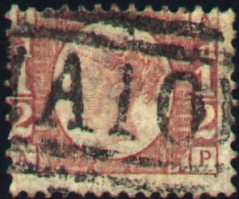
1/2 p orange (small size) 1/2 p green (small size) 1 p red 1 p black 1 p green 1 p brown 1 p grey 2 1/2 p blue 4 p blue 4 p orange 4 p yellow 4 p brown 5 p brown 6 p green 6 p lilac 1 Sh grey 1 Sh blue 1 Sh brown 1 Sh red (2 shades) 1 Sh orange Surcharged
'1d' on '2 1/2 PENCE' on 1 p red 'ONE PENNY' on 6 p green '2 1/2 PENCE' on 1 p red '2 1/2 PENCE' on 1 p blue '2 1/2 d.' on 4 p brown 'THREE PENCE' on 1 p lilac '4 d' on 1 Sh red '5 PENCE' on 4 p brown 'FIVE PENCE' on 6 p red Bisected and surcharged
'd 1/2' (red) on 6 p green 'd. 1' (red) on 6 p green
For the specialist, the first stamps of this issue didn't have any watermark (from 1861 to 1871). The stamps 1 p red, 4 p blue, 6 p green and 1 Sh grey were issued in 1861, the 4 p orange, 1 Sh blue and 1 Sh brown followed in 1869 (so all without watermark). From 1871 to 1883 the watermark 'small star' was used on 1/2 p orange, 1 p black, 1 p green, 1 p grey, 4 p blue, 6 p green, 1 Sh red. Finally from 1883 onwards the watermark 'CA crown' was used on 1/2 p green, 1 p grey, 1 p red, 2 1/1 p blue, 4 p blue, 4 p brown, 4 p yellow, 5 p brown, 6 p green, 6 p lilac, 1 Sh red. For a detailed description of all the varieties in perforation and colours, see a specialized catalogue.
Surcharged "REVENUE" or "Revenue" for fiscal use, click here.
Imperforate stamps are proofs, the values 1 p red and 4 p blue exist imperforate, example:
Value of the stamps |
|||
vc = very common c = common * = not so common ** = uncommon |
*** = very uncommon R = rare RR = very rare RRR = extremely rare |
||
| Value | Unused | Used | Remarks |
| No watermark (1861), various perforations | |||
| 1 p red | R | R | |
| 4 p blue | RR | RR | |
| 4 p orange | RR | RR | |
| 6 p green | RR | R | |
| 1 Sh grey | RR | RR | |
| 1 Sh brown | RRR | RR | |
| 1 Sh blue | RRR | RR | |
With watermark 'Small Star' (1871), various perforations |
|||
| 1/2 p orange | *** | *** | |
| 1 p black | R | R | |
| 1 p green | RR | *** | |
| 1 p grey | RR | R | |
| 4 p blue | RRR | RR | |
| 6 p green | RRR | RR | |
| 1 Sh red | RRR | RR | Two shades of red |
| With watermark 'CA Crown' (1883) | |||
| 1/2 p green | R | R | Perforation 12 |
| 1/2 p green | * | * | Perforation 14 |
| 1/2 p orange | RRR | RRR | Perforation 12 |
| 1 p grey | R | *** | Perforation 14 |
| 1 p red | ** | * | Perforation 14 |
| 2 1/2 p blue | *** | *** | Perforation 14 |
| 4 p blue | RRR | RR | Perforation 14 |
| 4 p blue | RR | RR | Perforation 12 |
| 4 p brown | R | R | Perforation 14 |
| 4 p yellow | ** | *** | Perforation 14 |
| 5 p brown | *** | *** | Perforation 14 |
| 6 p green | RR | RR | Perforation 12 |
| 6 p lilac | *** | *** | Perforation 14 |
| 1 Sh orange | RR | RR | Perforation 12 |
| 1 Sh red | *** | *** | Perforation 14 |
| Bisected and surcharged | |||
| 1/2 d on half of 6 p | RR | RR | Watermark 'Small Star' |
| 1 d on half of 6 p | RRR | RRR | Watermark 'Small Star' |
| Surcharged | |||
| 1 p on 2 1/2 p on 1 p | R | R | Watermark 'CA Crown', perforation 14 |
| 1 p on 6 p | RRR | RRR | Watermark 'Small Star' |
| 2 1/2 p on 1 p red | *** | *** | Watermark 'CA Crown', perforation 14 |
| 2 1/2 p on 1 p blue | ** | ** | Watermark 'CA Crown', perforation 14 |
| 2 1/2 p on 4 p | RR | RR | Watermark 'CA Crown', perforation 14 |
| 3 p on 1 p | *** | *** | Watermark 'CA Crown', perforation 14 |
| 4 p on 1 Sh | RRR | RRR | Watermark 'Small Star' |
| 5 p on 4 p | R | R | Watermark 'CA Crown', perforation 14 |
| 5 p on 6 p | *** | *** | Watermark 'CA Crown', perforation 14 |
Spiro forgeries:
The most common forgeries are Spiro forgeries (see pictures above). In these forgeries the queen looks angry and the background of lines is poorly imitated. The "T" of "ST." has its vertical stroke much thinner than the genuine stamps (See Album Weeds). Below this "T" there should be a square stop, however, in this forgery it is sometimes round (but also square sometimes). "St VINCENT" is written too tall. For those who understand printing techniques, the originals are engraved in taille-douce while the forgeries are lithographed. The cancels are typical 'Spiro' cancels that were not used on this island (mostly a british colonies cancel with empty center). Of course, there is also the absence of a watermark in the forgeries (but also in the first issues of the genuine stamps). Finally there are sometimes separating lines between the forgeries that are sometimes visible (see the 1 p black above for an example). I have seen the following values of the Spiro forgeries: 1 p black, 1 p red, 4 p blue, 4 p orange, 6 p green, 1 Sh blue, 1 Sh grey. They were produced around 1870.
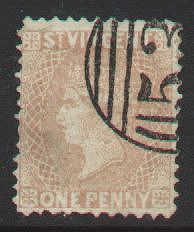

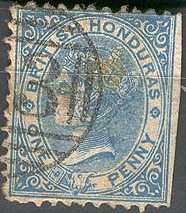
Same forgery type but with a different numeral
cancel "53" as in the Sierra Leone or British
Honduras forgery next to it.
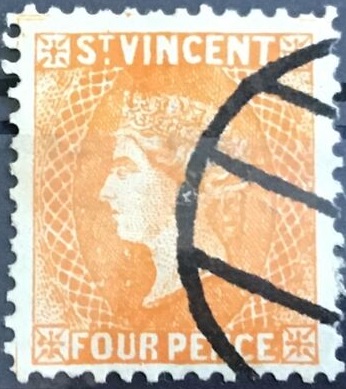

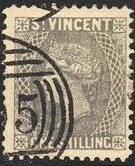
Forgeries with a peculiar giant
circle with horizontal lines, a squares
cancel and a "905" numeral
cancel; these cancels can be found on many other forgeries of
other countries.

I've seen the 1 Sh with a cancel consisting of four concentric
circles with "909" or
"606" in the center.
Panelli forgeries:

Distinguishing characteristics of a Panelli forgery; the line
under "ST.VINCENT" is crooked.
Another forger who made forgeries of St.Vincent is Panelli (or possibly Oneglia?). According to Peter Elias they were produced in 1927 and look much more dangerous. These forgeries were engraved, the watermark is a 5-pointed star (in the genuine stamps it is a 6-pointed star). The stamps are too heavily inked. Finally, the line under "ST.VINCENT" is crooked. In the 1 Sh stamp the "G" of "SHILLING" has a horizontal bar, which is absent in the genuine stamps. These forgeries are not very common. Peter Elias shows the values 1 p red, 4 p yellow, 4 p dark blue, 6 p emerald green (shown above), 6 p dark blue-green, 6 p apple green and 1 Sh red. I've also seen the value 6 p lilac.
Other forgeries:
Could the above stamp be the second forgery described in Album Weeds? The face has a very sauer expression and the whole stamp is quite blur. The jewels on top of the head of the queen can not be distinguished. Also note the very bad inscriptions. The inscription seems to be "V IN CEN T".
The above forgery is of a unknown forger, according to Peter Elias it is too short, the corner ornaments are crude, the portrait differs from the genuine stamp and it is printed on very thick paper (this forgery is very scarce). Also not the very thin 'St'. I have also seen the 1 p green of this particular forgery. I've seen these forgeries cancelled with a pattern of dots, concentric rings (with a number in the center?) and some red cancel (too faint to be recognizable). These forgeries are not very common.

A primitive forgery of the 1 p brown value, I've also seen this
forgery in the color green. Note the sharp nose of the Queen and
the peculiar shading on the face. It might be the same forgery
type as the one shown above.
I've seen another crude forgery of the 1 p red, where the "T" of "ST" is too long and has no dot under it.
Another forgery of the 1/2 p is shown above; the color is quite faded in the yellow stamp. I've seen different cancels on these forgeries: bars (horizontal and vertical at the same time), a numeral "10?" cancel (see image above), an ellipse with horizontal lines. The green 1/2 p stamp is possibly made by the same forger.
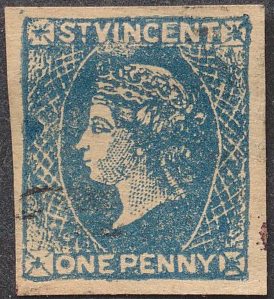
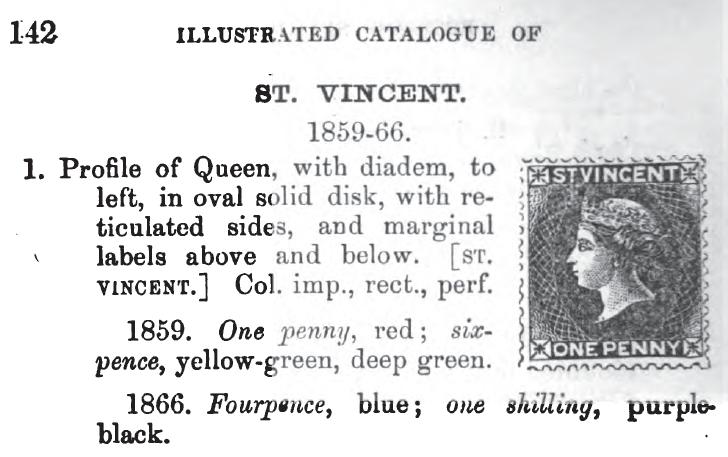
Forgery resembling an image in "The illustrated catalogue of
postage stamps" by J.E.Gray (1870, page 142, see second
image). A similar image appears in the Torres catalogue of 1879.
The above forgery of the 1 p blue is very primitive and imperforate.

Other primitive forgery of the 1 p red value

I've been told that this primitive forgery of a bisected 6 p
stamp was made in India, I have no further information.
Forged overprints:

Forged overprint, it should be red!

A forged overprint of the 1 d with wrong perforation.
Be also careful with the other overprints, many of them are forged as well!



Example: forged '2 1/2 d.' overprint on 4 p and forged '4d' on 1
Sh overprints.
For stamps issued in St Vincent from 1880 to 1901, click here.